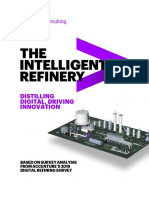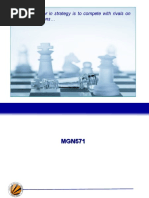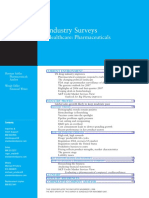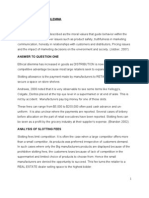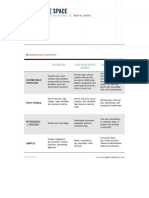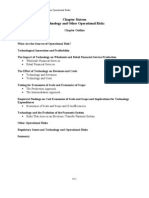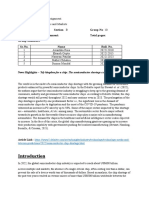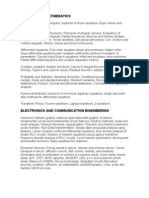McKinsey - Creating Value in Semiconductor Industry
McKinsey - Creating Value in Semiconductor Industry
Uploaded by
brownbag80Copyright:
Available Formats
McKinsey - Creating Value in Semiconductor Industry
McKinsey - Creating Value in Semiconductor Industry
Uploaded by
brownbag80Copyright
Available Formats
Share this document
Did you find this document useful?
Is this content inappropriate?
Copyright:
Available Formats
McKinsey - Creating Value in Semiconductor Industry
McKinsey - Creating Value in Semiconductor Industry
Uploaded by
brownbag80Copyright:
Available Formats
5
Despite its moderate size, the semiconductor
industry contributes disproportionately to growth
in US labor productivity and delivers tremen-
dous value to consumers. The industry, along with
the electronics industry it does so much to
power, contributed more than 25 percent of total
US productivity growth from 1995 to 1999
more than any other sector. That four-year period
outshined overall productivity growth from
1987 to 1995, according to an analysis published
by the McKinsey Global Institute.
1
Much of the tremendous growth seen in the
electronics industry over the last three decades
comes directly from the increasing power and
decreasing price of semiconductors, a function of
Stefan Heck,
Sri Kaza,
and Dickon Pinner
Creating value in the
semiconductor industry
Moores Law.
2
This performance improvement
enables the electronics industry to continually
produce devices and systems that are smaller, more
powerful, and richer in features at lower prices.
It has famously been noted that if the automotive
industry had achieved similar improvements
in performance in the last 30 years, a Rolls-Royce
would cost only $40 and could circle the globe
eight times on one gallon of gaswith a top speed
of 2.4 million miles per hour.
However, most chip makers capture only a small
percentage of the tremendous value they create;
consumers receive the lions share. Indeed, despite
its large positive impact on overall economic
growth, the semiconductor industry (excluding
In light of increasing consolidation throughout the semiconductor value chain,
companies that wish to succeed must move quickly to close capability gaps.
1
US productivity growth
19952000: Understanding
the contributions of infor-
mation technology relative to
other factors, McKinsey
Global Institute, October 2001.
2
According to Gordon Moore,
a founder of Intel, the number
of transistors that can be
ftted into a single chip doubles
roughly every two years,
resulting in both faster perfor-
mance and lower cost.
6 McKinsey on Semiconductors Autumn 2011
Intel) destroyed approximately $47 billion
in value for shareholders between 1996 and 2009
(Exhibit 1). To put that fgure, and the signif-
cant disparity seen in the industry, into context,
Intel alone created about $57 billion in value
during that same time period.
The economic challenges that the semiconductor
industry faces can be attributed to a confuence of
two factors: cyclicality, and rising costs in
R&D and on the capital-investment side of the
ledger, due to the increasing costs of upgrading
existing fabrication plants and building
new ones.
The cycle, while bad for the industry, is in
some ways a blessing for underperformers, who
have been able to stay in business because
the profts they generate during a cyclical upturn
enable them to sustain their operations during
a downturn and attract funds for capital invest-
ments beyond market requirements, which
initiates the next cyclical downturn. Government
interest in building semiconductor industries
most recently in China and Indiaaccentuates
this problem.
As for R&D, chip makers invest heavily, driven to
meet the expectations of Moores Law: costs have
Exhibit 1
Positive economic prot (EP)
1
$ billion
Negative EP
The semiconductor industry, excluding Intel, destroyed
$47 billion of value from 1996 to 2009.
MoSC 2011
Value creation
Exhibit 1 of 7
1
Positive EP in each year of the time period. In addition, Intel had a positive EP of $57 billion during this
period. EP is calculated as net operating prot less adjusted taxes (capital charge, where capital charge is
invested capital at previous year end weighted average cost of capital).
Source: Corporate Performance Center Semiconductor Database; McKinsey analysis
91 47
91
138
TSMC 14.3
Samsung 14.0
Qualcomm 13.6
Texas Instruments 9.5
Applied Materials 6.0
Mediatek 5.1
Linear 3.1
Maxim 2.4
Rohm 2.1
Analog Devices 2.1
Altera 1.6
Xilinx 1.4
KLA 1.4
Nvidia 1.4
Microchip 1.2
Synopsys 1.2
ASML 1.0
Others 10.0
7 Creating value in the semiconductor industry
naturally risen along with the ever-increasing
complexity of the chips. In addition, the
investment hurdle for building a state-of-the-art
chip fab continues to rise.
All that said, it is important to remember that
the $47 billion of destroyed value is an aggregate
fgure made up of many losers and several
disproportionate successes. Indeed, in many
segments, the top performer generates more than
100 percent of the total value. How do the top
performers succeed? They implement operational-
improvement programs for product lines that can
hit acceptable targets for return on invested capital
(ROIC), and judiciously divest those that cannot.
Companies that wish to thrive must follow this
example. They must optimize for ROIC rather than
share or gross margin, a process that entails
identifying improvement levers relating to each com-
ponent of ROIC and designing initiatives targeted
to each. Lean operations approaches, including best-
practice manufacturing techniques, exert direct
impact on ROIC and are therefore key levers in this
frst step.
The companies that have successfully followed
this two-step model have achieved improvements in
ROIC in the range of 5 percentage points. Some
companies have improved ROIC by as much as 20 to
30 percentage points.
Understanding the sources of
value destruction
Although an analysis of income statements shows
a number of proftable players in the semiconductor
industry, most players are not able to generate
economic proft; that is, their ROIC lags behind
8 McKinsey on Semiconductors Autumn 2011
their weighted average cost of capital. Indeed,
disaggregating the industry by business model and
subsegment reveals that in most segments, only
one or two players create value.
As we have indicated, the industry as a whole
has struggled to generate economic proft because
three factors present unique challenges to
chip manufacturers.
Historically, the semiconductor industry
has shown strong cyclical behavior. During
a typical upturn of one to two years, most
companies generate profts, which they use to
sustain their operations during the down-
turn. In addition, many players use their strong
performance during an upturn to entice
investors in the public markets or get new
loans to fund capital investments; in many cases,
governments subsidize these refnancings
(Exhibit 2).
But precisely because investment runs ahead of
market demand in the upturn, the period
is followed by a longer downturn or a very slow
growth period, during which poor per-
formers struggle. There is some evidence to
suggest that both the amplitude and time
frame of the industrys cyclicality is moderating,
but it is likely that some degree of cyclicality
will remain.
The skyrocketing costs of R&D and the increasing
amount of capital required to build a state-of-
Exhibit 2
Sources of nancing for poor performers
1
1996
110
100
90
80
70
60
50
40
30
20
10
0
10
20
30
1998 2000 2002 2004 2006 2008 2010
Financing continues to ow from private investors and
governments as poor performers fail to deliver.
MoSC 2011
Value creation
Exhibit 2 of 7
1
This includes the 59 players with the lowest average economic prot/revenue.
Source: Compustat; Corporate Performance Center analysis
Cumulative operating
cash ow net capital expenditure
Net debt nancing
Equity nancing
net of dividends
and buybacks
Performance improvement
is contingent on change in
economic behavior
Investors and governments
cease to fund value-destroying
players in the future
Players focus not only
on the top line but also on
operational efciency
$
b
i
l
l
i
o
n
,
a
n
n
u
a
l
9 Creating value in the semiconductor industry
the-art fab add to the industrys economic
challenges. Chip makers continue to pour money
into R&D as new designs and process tech-
nologies become increasingly expensive to develop.
In 2009, R&D spending amounted to approx-
imately 17 percent of industry revenue for semi-
conductor companies (up from 14 percent
a decade earlier) versus 3 percent for automakers,
to take one example. The cost of building
leading-edge fabs continues to increase as well;
for example, the average 8-inch fab costs
$1.6 billion to build, while a state-of-the-art
12-inch fab costs $3 billion to $4 billion. Similarly,
the costs for developing process technologies on
new nodes is increasing dramatically; for example,
the average cost of developing a 90-nanometer
logic process technology is approximately
$300 million, while the cost of developing a modern
45-nanometer logic process technology
is approximately $600 million, representing a
doubling of spend in roughly fve years
(Exhibit 3).
Exhibit 3
Integrated device manufacturers: company revenue required to
sustain leading-edge fab investments
Only Intel
and Samsung
can invest
beyond 22nm
2009 semiconductor revenue, $ billion
Intel
2.9
90nm
2004
65nm
2006
45nm
2008
90nm
2004
65nm
2006
45nm
2008
22nm
2012
22nm
2012
3.8
5.2
7.0 9.5
Sony
ST
NXP
Samsung
Freescale
Inneon
Texas
Instruments
Leading-edge fab investment Process-development cost
Fewer logic integrated device manufacturers are able to
sustainably invest in leading-edge nodes.
MoSC 2011
Value creation
Exhibit 3 of 7
1
Nanometers.
Source: iSuppli; literature search; McKinsey analysis
Minimum-revenue-
level assumptions
R&D per product (fab
investment/process
development, $ billion):
65nm:
1
2.4/0.6
45nm: 3.3/0.7
32nm: 4.4/1.0
22nm: 6.0/1.4
Node developed
over 3 years
R&D as 1012% of
revenue
Node introduced every
2 years
17.5
9.7
8.5
4.5
4.5
3.4
32.4
3.2
2.4
2.6
3.3
6.5
32.4
17.5
9.7
8.5
4.5
4.5
3.4
3.2
Revenue level required
for sustainable
leading-edge fab
investment
10 McKinsey on Semiconductors Autumn 2011
Exhibit 4
Capital spending/semiconductor
revenue is decreasing . . .
C
r
i
t
i
c
a
l
e
x
p
o
s
u
r
e
s
y
s
t
e
m
c
o
s
t
,
$
t
h
o
u
s
a
n
d
Line width, nanometers
. . . even though capital
costs are rising
%
1995
35
30
25
20
15
10
5
0
100,000
G-line
I-line
KrF
ArF
ArF-1
EUV
10,000
10,000
1,000
150mm
200mm
300mm
450mm
1,000
100
100 0 2000 2005 2010 2015
Fab lite strategies have reduced capital expenditures, and at
the same time, overall capital costs are rising sharply.
MoSC 2011
Value creation
Exhibit 4 of 7
Source: IC Insights; IC Knowledge
In response to these higher costs, many
semiconductor companies have resorted to fab
lite strategies, outsourcing an increasingly
large fraction of their chip production to dedicated
manufacturing foundries. Although this has
resulted in an overall net reduction of capital
expenditures in the industry, from an average of
approximately 27 percent of revenues (from
1996 to 2001) to approximately 20 percent of
revenues (from 2002 to 2009), it has also
led to intense cost pressure on chip makers that
continue to handle all their manufacturing
in-house (Exhibit 4). The shift of manufacturing to
Asia has created additional cost pressures
on those that have yet to transfer operations to
lower-cost locations.
Prices also remain under pressure in the industry
as consumer applications become the main
force driving the semiconductor market. The much
higher elasticity of demand as prices decline
has further accelerated the erosion of average
selling prices.
All these pressures are intensifed by the shift in
the end-user market to Asia. Furthermore, the lack
of a killer app on the horizonand the slower
growth of traditional large, high-growth markets
such as PCs and mobile phonesmeans that
the economic pressures on the industry are not
likely to abate anytime soon.
Learning from the top performers
A handful of semiconductor players have
consistently generated a disproportionate amount
of value in this industry. An analysis of the key
attributes of these companies, as well as those of
the leading players in other industries, sug-
gests the two major lessons noted earlier for those
who seek to capture economic profts in
semiconductors: successful players work to
improve ROIC where it can be satisfactorily
11 Creating value in the semiconductor industry
improved, and they aggressively prune product
portfolios of businesses that do not look likely to
become suffciently proftable.
As far as ROIC is concerned, top performers
focus on changing the dynamics and structure
within a given segment as they seek to build
leading positions early on. Acquiring and holding
a market share of 40 percent or more within
a segment enables companies to drive higher
profts (Exhibit 5). Such companies typically have
closer relationships with key customers,
advanced R&D processes that yield better innova-
tion road maps (which are also more closely
aligned with the key value drivers for their segment),
deeper insight derived from having a more
complete picture of where the market is going, and
in many cases, a greater ability to maintain
margins through downturns.
To achieve this kind of performance, semiconductor
companies must optimize ROIC by executing
operational-improvement programs, including
but not limited to making lean operational
improvements, targeting proftability (rather than
other measures), improving asset utilization,
and tuning their capital-asset strategy (that is,
make versus buy) to further improve return
on capital. To target areas for improvement, a
detailed ROIC tree can be used to disaggregate the
components of revenue, cost, and invested
capital and thus identify the main value-creation
levers for each component. Exhibit 6 lists
examples of value-creation levers and the impact
that these levers help companies achieve.
By helping companies implement lean-
manufacturing techniques, we have assisted
more than 10 semiconductor companies
in increasing the throughput of their fabs by 20 to
30 percent (with minimal additional capital
expenditure). Naturally, this has been a signifcant
driver of improved ROIC, as well as incremental
gross margin. These gains have been achieved by
Exhibit 5
A
v
e
r
a
g
e
r
e
t
u
r
n
o
n
i
n
v
e
s
t
e
d
c
a
p
i
t
a
l
,
2
0
0
7
0
9
,
%
Market share, 2009
Lattice
Freescale (DSP)
AMD (MPU)
Hynix (DRAM)
Samsung (DRAM)
Applied Materials
(deposition)
UMC
TEL
TSMC (foundry)
Xilinx (PLD) Intel (MPU)
Texas
Instruments
(DSP)
0
50
40
30
20
10
0
10
20
30
20 40 60 80 100
A high segment market share enables companies to shape
their future and earn higher returns.
MoSC 2011
Value creation
Exhibit 5 of 7
Source: Corporate Performance Center Semiconductor Database; iSuppli; Gartner
Leading player
No. 2 or 3 player
12 McKinsey on Semiconductors Autumn 2011
Exhibit 6
Key levers to drive ROIC
Companies have employed a number of strategies
to achieve impact.
MoSC 2011
Value creation
Exhibit 6 of 7
1
Return on invested capital.
Revenue
Cost ROIC
1
Capital
Strategic
Tactical
Fixed
Variable
Develop products and drive efciency and effectiveness
in new-product introduction
Employ a new market-development strategy
Pricing: improve discipline and value communication
Sales-force effectiveness: optimize coverage
and productivity of eld sales force
Account protability: realize value from investing
in key accounts
Improve fab throughput and drive lean operations
Employ strategic sourcing focused on total cost of materials
Optimize consumption to reduce material usage
Optimize supply chain
Use fabless/fab lite strategy and optimize footprint
Improve capital-expenditure planning and purchasing strategy
Reduce general and administrative costs,
optimize performance
Optimize R&D spend/portfolio, rationalize products
+
+
maximizing overall equipment effectiveness,
a technique that exposes all the losses attributable
to bottleneck machines in a 24-hour period,
thereby allowing companies to focus on reducing
the largest losses. This technique was as
effective in 4-inch, 5-inch, 6-inch, and 8-inch fabs
(the older, trailing-edge fabs) as it was when
deployed in leading-edge 12-inch fabs.
In trailing-edge fabs, most of the improvements
are captured from increasing the uptime of
bottleneck machines, for example, by minimizing
machine changeovers and setups and optimizing
material handling to ensure that a bottleneck
machine is never left idle. By contrast, in leading-
edge fabs, many of the improvements come
from reducing the process time of an individual
wafer by tailoring the sequence of tasks of
the bottleneck machine to a specifc recipe (the
unique fow of manufacturing process steps
required to fabricate the wafer) and eliminating
recipe redundancy. For example, dielectric
thin-flm deposition times can be decreased, with a
corresponding increase in the throughput of
deposition equipment, by reducing the thickness
of excess dielectric material. This has the
added benefts of increasing both the throughput
of chemical-mechanical-planarization (CMP)
machines (because less excess material is removed
in the polishing process) and the lifetime of the
CMP pads.
Another lever that can help improve ROIC is
pricing, and we recommend chip makers use value-
based pricing and transactional pricing to
drive revenue increases of 2 to 7 percent. Value-
based pricing processes enable companies
to set prices equivalent to the value perceived by
13 Creating value in the semiconductor industry
customers by identifying the individual value
drivers of a product, interviewing customers to
understand the importance of each of these drivers
to their purchasing decisions, understanding
the degree of differentiation the company possesses
with regard to each driver, and translating this
value into price. Transactional pricing, by contrast,
focuses on minimizing the leakage of value in
the fnal price relative to the list price. This leakage
is analyzed with regard to variance (differences
in discounting or margin performance), slippage
(deviations from established policies, guide-
lines, or programs), and structure (suboptimal
pricing structures, processes, or delegation
levels, resulting in unnecessarily low net prices).
Setting aside ROIC, the second main lever involves
proactively managing product portfolios: investing
in market segments that are growing, either
organically or through acquisition, and divesting
segments in which growth or margins are low.
In reviewing its portfolio, a company may fnd that
it includes some fast-growing businesses with
high proft margins as well as other businesses in
which the company has achieved limited suc-
cess despite years of investment. Top-performing
companies actively evolve their portfolios as
markets mature or become less attractive. Rather
than engaging in a price war to increase their
share of a stagnating market, for example, they
drop out of businesses that offer little hope
of proftability (Exhibit 7).
Several top performers have been particularly
successful with this approach. Texas Instruments
has divested more than 15 lower-growth, lower-
Exhibit 7
Choice of market is the most important
contributor to growth . . .
Sources of growth
Choice of market/
market growth
Market-share gain
M&A
Contribution to growth
1
Average contribution for semiconductor
peer group,
2
200508, %
. . . and companies performance in
choosing markets differs widely
It has become even more critical for semiconductor companies
to focus on the right markets.
Growth from choice of market
Yearly growth attributable to choice
of market, 200508, %
MoSC 2011
Value creation
Exhibit 7 of 7
1
Only positive contributions to growth have been included in the analysis.
2
AMD, Broadcom, Inneon, Intel, Mediatek, NEC, NXP, Panasonic, Qualcomm, Sony, ST, Texas Instruments, and Toshiba.
Source: Annual reports; McKinsey analysis of granularity of growth
70
19
11
Top performer
9.2
Worst performer
1.6
5
Companies ability to identify the right
markets to compete in has a
signicant inuence on their total
growth performance
14 McKinsey on Semiconductors Autumn 2011
margin businesses in the past 15 years (including
its DRAM and defense-controls units) to focus on
the wireless business, as well as to develop a
medical business. Qualcomm focuses on the large,
high-growth wireless-handset market and, by
controlling intellectual property such as the CDMA
and WCDMA chip sets, is able to generate
signifcant profts through licensing arrangements,
creating an additional revenue stream that does
not entail building chips. Applied Materials ability
to enter key new growth segments (such as
rapid thermal processing, copper deposition, and
solar) while shifting its mix away from
underperforming segments (such as implants) has
enabled it to maximize proftability. As these
examples illustrate, it is crucial for semiconductor
companies to develop solid portfolio strategies
and to actively manage their portfolios over time.
Put another way, just as the technologies
and processes in the fabs evolve, so must the
composition of the corporation.
The inability of many semiconductor companies to
create value is one of the key factors driving
consolidation throughout the industrys value
chain today. Indeed, as private-equity
players set their sights on the industry, under-
performing companies face a stark choice:
they can either follow the lead of top performers
and undertake initiatives to improve perfor-
mance, thus helping shape the industrys structure,
or they can leave it to acquirers to step in and
drive a new dynamic of value creation. Those that
choose the former course must begin by
evaluating whether they have the strategic,
organizational, and operational capabil-
ities to pursue a performance transformation.
If such companies lack these capabilities
but still wish to control their future, they must
move quickly to close capability gaps before
embarking on the journey.
Stefan Heck is a director in McKinseys Stamford offce, Sri Kaza is an associate principal in the Silicon Valley
offce, and Dickon Pinner is a principal in the San Francisco offce. Copyright 2011 McKinsey & Company.
All rights reserved.
You might also like
- William Empson Alice in Wonderland - The Child As Swain PDF100% (2)William Empson Alice in Wonderland - The Child As Swain PDF18 pages
- #Mitin - Introduction To Nano ElectronicsNo ratings yet#Mitin - Introduction To Nano Electronics328 pages
- Electrostatic Discharge (ESD) Control (D-1348), Rev. F100% (1)Electrostatic Discharge (ESD) Control (D-1348), Rev. F25 pages
- Global Semiconductor Growth - Encouraging 2024 - 2025 IndicatorsNo ratings yetGlobal Semiconductor Growth - Encouraging 2024 - 2025 Indicators11 pages
- Chicken Game in Semiconductor Industry PDFNo ratings yetChicken Game in Semiconductor Industry PDF2 pages
- Intelligent Platform Management Interface Specification v0.9No ratings yetIntelligent Platform Management Interface Specification v0.9134 pages
- Iot Opportunity in The World of Semiconductor Companies: July 2018No ratings yetIot Opportunity in The World of Semiconductor Companies: July 201834 pages
- Metals and Mining No7 Commercial Excellence in MiningNo ratings yetMetals and Mining No7 Commercial Excellence in Mining7 pages
- Intel Corporation Analysis: Strategical Management - Tengiz TaktakishviliNo ratings yetIntel Corporation Analysis: Strategical Management - Tengiz Taktakishvili12 pages
- Bain IVCA India Venture Capital Report 2022 1648706342No ratings yetBain IVCA India Venture Capital Report 2022 164870634242 pages
- Chips With Everything: Lessons For Effective Government Support For Clusters From The South West Semiconductor IndustryNo ratings yetChips With Everything: Lessons For Effective Government Support For Clusters From The South West Semiconductor Industry28 pages
- Roland Berger Practice Business Case 20100201No ratings yetRoland Berger Practice Business Case 201002018 pages
- The Worst Error in Strategy Is To Compete With Rivals On Same Dimensions100% (1)The Worst Error in Strategy Is To Compete With Rivals On Same Dimensions43 pages
- Traditional Consolidation End-Game Framework - v1.0No ratings yetTraditional Consolidation End-Game Framework - v1.012 pages
- Roland Berger - The Lithium-Ion Battery Market and Supply Chain - 2022 - FinalNo ratings yetRoland Berger - The Lithium-Ion Battery Market and Supply Chain - 2022 - Final38 pages
- An Investigation Into Nokia Microsoft Strategic Alliance Joining Forces in The Global Smartphone IndustryNo ratings yetAn Investigation Into Nokia Microsoft Strategic Alliance Joining Forces in The Global Smartphone Industry7 pages
- Industrial Stocks Are Getting Ready For 10 Years of Outperformance - Barron'sNo ratings yetIndustrial Stocks Are Getting Ready For 10 Years of Outperformance - Barron's7 pages
- The Potential Shake-Up in Semiconductor Manufacturing Business ModelsNo ratings yetThe Potential Shake-Up in Semiconductor Manufacturing Business Models5 pages
- Mechanical Engineering 2015: Strategies For A Changed WorldNo ratings yetMechanical Engineering 2015: Strategies For A Changed World4 pages
- Investors Presentation: Roy Porat, CEO - Moshe Eisenberg, CFONo ratings yetInvestors Presentation: Roy Porat, CEO - Moshe Eisenberg, CFO22 pages
- Business Models Performance 12 July 2006No ratings yetBusiness Models Performance 12 July 200636 pages
- McKinsey - Mapping The Value of Employee CollaborationNo ratings yetMcKinsey - Mapping The Value of Employee Collaboration14 pages
- SIA - Semiconductor - Overview - March 2013BNo ratings yetSIA - Semiconductor - Overview - March 2013B1 page
- NCDD08 Uncertainty Methods-WorkshopHandoutNo ratings yetNCDD08 Uncertainty Methods-WorkshopHandout28 pages
- Applicants Signature Application For The Grant/Renewal of Pio CardNo ratings yetApplicants Signature Application For The Grant/Renewal of Pio Card3 pages
- Intel - Thermal Design For Embedded AppsNo ratings yetIntel - Thermal Design For Embedded Apps28 pages
- Town Lake Trail Map: Trail Distances From Bridge To BridgeNo ratings yetTown Lake Trail Map: Trail Distances From Bridge To Bridge0 pages
- Tedium Ennui Dreary Anodyne Muzak Day After Week After Month After Year AfoulNo ratings yetTedium Ennui Dreary Anodyne Muzak Day After Week After Month After Year Afoul1 page
- Details PDF: Image Part Number Description Manufacturer QuantityNo ratings yetDetails PDF: Image Part Number Description Manufacturer Quantity1 page
- Ec73 - RF and Microwave Engineering Unit: 1 Two Port RF Networks-Circuit Representation 2 Marks Questions and AnswersNo ratings yetEc73 - RF and Microwave Engineering Unit: 1 Two Port RF Networks-Circuit Representation 2 Marks Questions and Answers27 pages
- Download Compiling Algorithms for Heterogeneous Systems Steven Bell ebook All Chapters PDF100% (2)Download Compiling Algorithms for Heterogeneous Systems Steven Bell ebook All Chapters PDF55 pages
- Improve Clock Tree Efficiency For Low Power Clock Tree DesignNo ratings yetImprove Clock Tree Efficiency For Low Power Clock Tree Design3 pages
- PCB Thermal Simulation - The State of The Art: Alexandra Francois-Saint-Cyr100% (1)PCB Thermal Simulation - The State of The Art: Alexandra Francois-Saint-Cyr35 pages
- Esd Protection Design Guide: Tvs Diode Arrays: ©2012 Littelfuse, Inc 1No ratings yetEsd Protection Design Guide: Tvs Diode Arrays: ©2012 Littelfuse, Inc 147 pages
- 0622 techUK UK Semiconductor Industry BEIS Select CommitteeNo ratings yet0622 techUK UK Semiconductor Industry BEIS Select Committee11 pages
- Engineering Mathematics: EC-Electronics and Communication EngineeringNo ratings yetEngineering Mathematics: EC-Electronics and Communication Engineering10 pages
- UNIT-1 Fundamentals of Information Technology (Question and Answers)100% (1)UNIT-1 Fundamentals of Information Technology (Question and Answers)13 pages
- William Empson Alice in Wonderland - The Child As Swain PDFWilliam Empson Alice in Wonderland - The Child As Swain PDF
- Electrostatic Discharge (ESD) Control (D-1348), Rev. FElectrostatic Discharge (ESD) Control (D-1348), Rev. F
- Global Semiconductor Growth - Encouraging 2024 - 2025 IndicatorsGlobal Semiconductor Growth - Encouraging 2024 - 2025 Indicators
- Intelligent Platform Management Interface Specification v0.9Intelligent Platform Management Interface Specification v0.9
- Iot Opportunity in The World of Semiconductor Companies: July 2018Iot Opportunity in The World of Semiconductor Companies: July 2018
- Metals and Mining No7 Commercial Excellence in MiningMetals and Mining No7 Commercial Excellence in Mining
- Intel Corporation Analysis: Strategical Management - Tengiz TaktakishviliIntel Corporation Analysis: Strategical Management - Tengiz Taktakishvili
- Bain IVCA India Venture Capital Report 2022 1648706342Bain IVCA India Venture Capital Report 2022 1648706342
- Chips With Everything: Lessons For Effective Government Support For Clusters From The South West Semiconductor IndustryChips With Everything: Lessons For Effective Government Support For Clusters From The South West Semiconductor Industry
- The Worst Error in Strategy Is To Compete With Rivals On Same DimensionsThe Worst Error in Strategy Is To Compete With Rivals On Same Dimensions
- Traditional Consolidation End-Game Framework - v1.0Traditional Consolidation End-Game Framework - v1.0
- Roland Berger - The Lithium-Ion Battery Market and Supply Chain - 2022 - FinalRoland Berger - The Lithium-Ion Battery Market and Supply Chain - 2022 - Final
- An Investigation Into Nokia Microsoft Strategic Alliance Joining Forces in The Global Smartphone IndustryAn Investigation Into Nokia Microsoft Strategic Alliance Joining Forces in The Global Smartphone Industry
- Industrial Stocks Are Getting Ready For 10 Years of Outperformance - Barron'sIndustrial Stocks Are Getting Ready For 10 Years of Outperformance - Barron's
- The Potential Shake-Up in Semiconductor Manufacturing Business ModelsThe Potential Shake-Up in Semiconductor Manufacturing Business Models
- Mechanical Engineering 2015: Strategies For A Changed WorldMechanical Engineering 2015: Strategies For A Changed World
- Investors Presentation: Roy Porat, CEO - Moshe Eisenberg, CFOInvestors Presentation: Roy Porat, CEO - Moshe Eisenberg, CFO
- McKinsey - Mapping The Value of Employee CollaborationMcKinsey - Mapping The Value of Employee Collaboration
- Applicants Signature Application For The Grant/Renewal of Pio CardApplicants Signature Application For The Grant/Renewal of Pio Card
- Town Lake Trail Map: Trail Distances From Bridge To BridgeTown Lake Trail Map: Trail Distances From Bridge To Bridge
- Tedium Ennui Dreary Anodyne Muzak Day After Week After Month After Year AfoulTedium Ennui Dreary Anodyne Muzak Day After Week After Month After Year Afoul
- Details PDF: Image Part Number Description Manufacturer QuantityDetails PDF: Image Part Number Description Manufacturer Quantity
- Ec73 - RF and Microwave Engineering Unit: 1 Two Port RF Networks-Circuit Representation 2 Marks Questions and AnswersEc73 - RF and Microwave Engineering Unit: 1 Two Port RF Networks-Circuit Representation 2 Marks Questions and Answers
- Download Compiling Algorithms for Heterogeneous Systems Steven Bell ebook All Chapters PDFDownload Compiling Algorithms for Heterogeneous Systems Steven Bell ebook All Chapters PDF
- Improve Clock Tree Efficiency For Low Power Clock Tree DesignImprove Clock Tree Efficiency For Low Power Clock Tree Design
- PCB Thermal Simulation - The State of The Art: Alexandra Francois-Saint-CyrPCB Thermal Simulation - The State of The Art: Alexandra Francois-Saint-Cyr
- Esd Protection Design Guide: Tvs Diode Arrays: ©2012 Littelfuse, Inc 1Esd Protection Design Guide: Tvs Diode Arrays: ©2012 Littelfuse, Inc 1
- 0622 techUK UK Semiconductor Industry BEIS Select Committee0622 techUK UK Semiconductor Industry BEIS Select Committee
- Engineering Mathematics: EC-Electronics and Communication EngineeringEngineering Mathematics: EC-Electronics and Communication Engineering
- UNIT-1 Fundamentals of Information Technology (Question and Answers)UNIT-1 Fundamentals of Information Technology (Question and Answers)

































